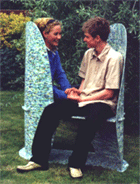:: Specific Design Brief
LOUGHBOROUGH UNIVERSITY:
Reduce, Reuse,
Recycle
LU
2:
HIGH ADDED VALUE - further information
PRODUCT DESIGN UK
- BACKGROUND
Recycled polymer materials
Recycled polymers can broadly match the technical properties of new polymers,
but it is very difficult to remove colour pigments. Consequently, recycled
polymers tend to be green, brown or black,, and these dark coloured pigments
have been added to ‘mask’ the original pigments. An alternative strategy is to
design the materials to be interesting mixed colours. This approach was
developed by Jane Atfield at the Royal College of Arts in the early 1990s and
such materials are now marketed by Smile Plastics Ltd.
(http://www.smile-plastics.co.uk).
Similar materials have been developed by Yemm&Hart in the US (http://yemmhart.com).
Some examples of materials available from Smile Plastics are shown below. These
materials are comparatively expensive to produce and are consequently likely to
be more expensive than alternatives you might select.
|
Material: HDPE bottle range type A. |
|
|
Material: HDPE bottle range type B. |
|
|
Material: HDPE bottle range type E. |
|
|
Material:
HIPS range type CH. |
|
|
Material:
HIPS range type CC. |
|
|
Material:
HIPS range type Y. |
|
Examples of materials available from Smile Plastics Ltd (Mansion House, Ford, Shrewsbury, SY5 9LZ. Tel: (01743) 850267. Fax: (01743) 851067.
Some issues that the design must address
• the design must be for a market with high added value
• either, the finish of the product must exploit the mixed colours and textures
available from recycled polymer materials
• or, a finishing method appropriate to the market must be used
• the best designs will exploit the natural qualities of recycled polymers
• the styling must be targeted towards the high end of the market
• the product must be fashionable
• the design and quality of the detailing must reflect the sophistication
expected of expensive products
FURTHER
SUPPORT INFORMATION
 The
design is for an electric violin, but electric cellos and guitars have also been
successfully designed and made. In this case, recycled high impact polystyrene
(HIPS) was used. This can be adhesively bonded and finished with conventional
spray paints. The design exploits the voids often found within recycled polymer
sheets formed by thermoforming, which are acoustically advantageous. (Recycled
polymers processed in other ways would not have such voids).
The
design is for an electric violin, but electric cellos and guitars have also been
successfully designed and made. In this case, recycled high impact polystyrene
(HIPS) was used. This can be adhesively bonded and finished with conventional
spray paints. The design exploits the voids often found within recycled polymer
sheets formed by thermoforming, which are acoustically advantageous. (Recycled
polymers processed in other ways would not have such voids).
 The
second design shows how the variegated nature of the recycled polymers can be
exploited in a garden environment, where all the surrounding vegetation is also
variegated. The recycled polymers look more natural than a single, new
monocolour polymer! This design was made from recycled high density polyethylene
(HDPE)
The
second design shows how the variegated nature of the recycled polymers can be
exploited in a garden environment, where all the surrounding vegetation is also
variegated. The recycled polymers look more natural than a single, new
monocolour polymer! This design was made from recycled high density polyethylene
(HDPE)
Further designs can be seen on the Department of Design and Technology’s
website.
(http://www.lboro.ac.uk/departments/cd/)





